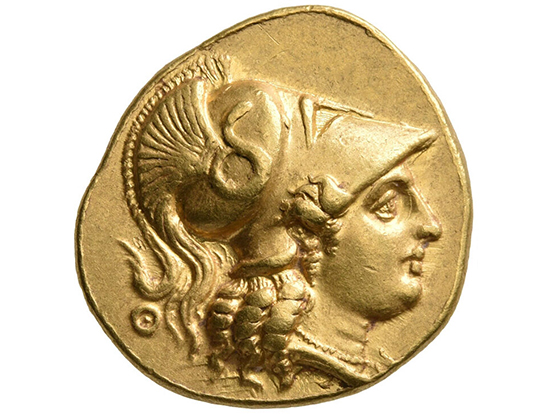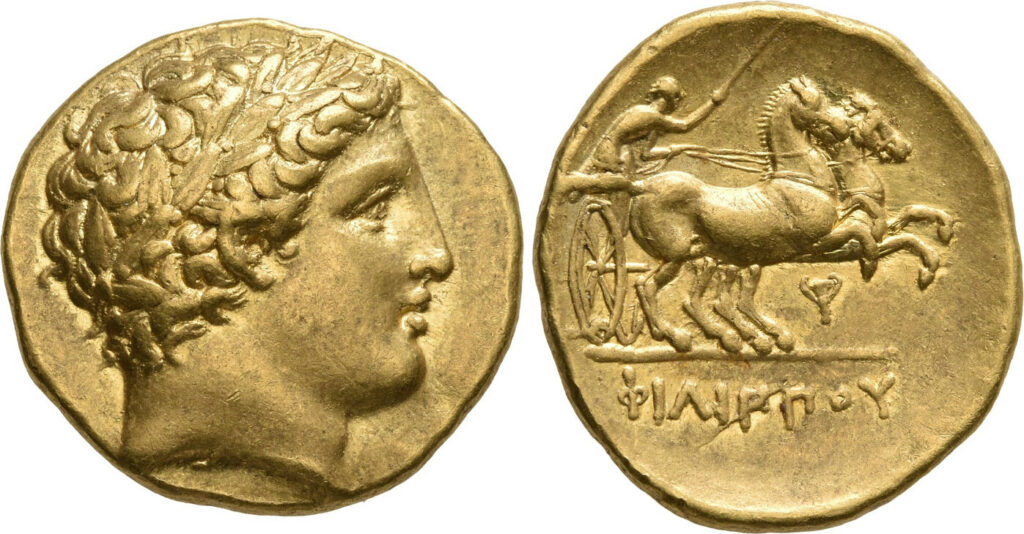The Kingdom of Macedonia, located in the northern part of ancient Greece, was a powerful state that rose to prominence under the leadership of King Philip II and reached its zenith under his son, Alexander the Great, in the 4th century BC.
The kingdom existed from roughly the 7th century BC to the 2nd century BC. During the reign of Philip II (359–336 BC) and Alexander the Great (336–323 BC), the Macedonian Empire became one of the largest empires in the ancient world. During this time, various coins were issued by the Macedonian rulers.
The coins from this period typically featured images of the ruling monarch, gods, or symbols representing the power and influence of the kingdom.
The most well-known coin associated with the Macedonian Empire is the silver tetradrachm, which was a widely circulated and recognized currency in the Hellenistic world.
These coins often featured the head of Heracles (Hercules) wearing a lion skin on the obverse side, as Heracles was considered a heroic figure and a symbol of strength.
The reverse side typically depicted a seated Zeus, the chief deity of the Greek pantheon, holding an eagle and a scepter. Some coins also depicted other mythological or symbolic figures.
It’s important to note that the designs of ancient coins could vary, and the specific details might differ based on the region, time period, and the issuing authority.
Philip II Coinage:
Philip II of Macedon (reigned 359–336 BC) introduced significant coinage reforms. He standardized the gold stater, known as the “Philip II staters,” which featured the head of Apollo on the obverse and a charioteer on the reverse. These coins were widely used and became a standard of trade.
AV Stater. 359-336 BC. Kingdom of Macedon. Philip II. EF
9,440.00 US$
Catalog: LeRider-pl. 57#146 (D33/R105)
Weight: 8.57 g – Diameter: 19.48 mm
Pella Mint, ca. 336-323 BC.
Early posthumous issue.
Laureate head of Apollo facing right./ Biga driving right, Cantharus below.
Beautifully toned and lustrous. Virtually as struck
Tetradrachm ca. 342/1-337/6 BC Macedonia, Philip II AU(50-53)
5,040.00 US$
Weight: 14.52 g – Diameter: 25.50 mm
Mint mark: Pella
Main character: Philip II
Laureate head of Zeus right., Youth, holding palm frond, on horseback right; thunderbolt below, [N in exergue]., Beautiful grey cabinet tone with golden reflections, double strike on obverse at the level of the horse. From the J.-P. Righetti Collection.
Alexander the Great’s Coinage:
After the death of Philip II, his son, Alexander the Great (reigned 336–323 BC), continued the coinage tradition. The most famous coins associated with Alexander are the silver tetradrachms, which typically featured a portrait of Alexander wearing the horn of Ammon on the obverse and a depiction of Zeus seated on the reverse.
Macedonia Gold Stater Alexander III. the Great (336-323 BC) VF/EF
6,585.00 US$
Weight: 8.47 g – Diameter: 17.00mm
Catalog: Price 164
Obv: Head of Athena to the right with a Corinthian helmet decorated with a snake.
Rev: Standing Nike to the left holding wreath and stylus. Lightning in left field.
Beautiful coin centrally minted, min. Marginal error.
Minted in an unknown mint in Macedonia.
Kingdom of Macedonia AR Tetradrachm 323-320 BC Antipater – Amphipolis mint aUNC_XF
1,640.00 US$
Catalog: Price 112
Weight: 17.27 g – Diameter: 24.00 mm
Kingdom of Macedonia. Alexander III 336-323 BC, AR Tetradrachm ca. 323-320 BC, Early posthumous issue of Amphipolis, by Antipater, under Philip III Arrhidaeus, Price 105, Silver 24 mm, weight 17,27 g., Condition aUNC/XF+, very attractive shiny specimen
Head of Heracles right, wearing lion’s skin / BAΣIΛEΩΣ-AΛEΞANΔPOY, Zeus seated left on backless throne, left leg drawn back, feet on ground line, eagle in right hand, scepter in left; Phrygian helmet right in left field.
Hellenistic Period:
Following Alexander’s death, his generals divided the empire, and the Hellenistic period began. The Diadochi, or successors, minted coins that often bore the portraits of their respective rulers. The Antigonid dynasty, descended from one of Alexander’s generals, continued to mint coins in Macedonia.
Roman Influence: In 168 BC, the Romans defeated the Macedonian forces at the Battle of Pydna, marking the end of the Macedonian monarchy. Macedonia became a Roman province, and its coinage was then influenced by Roman designs.
Many Macedonian coins have survived and are collected by numismatists and historians interested in the ancient world.
About Us:
MA-Shops.com, The World’s Most Trusted Numismatic Marketplace, offers more than a million ancient, U.S. and ancient coins, along with medals, banknotes, militaria and antiquities. Our vibrant collection is offered by verified and Certified Dealers from around the world. Collectors can search, select and purchase conveniently and confidently knowing every item is authentic and guaranteed. Founded in 2005 by Joachim Schwiening, MA-Shops has offices in Germany and the US.
To become a dealer or for more information, contact us at MA-Shops.com













